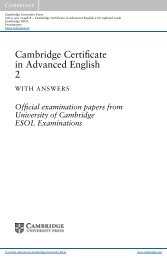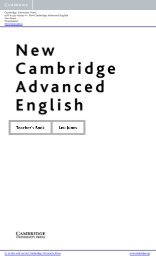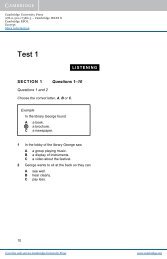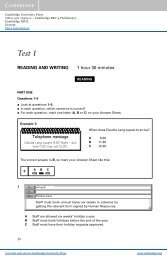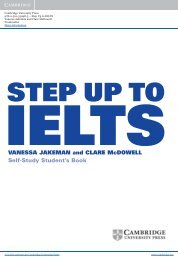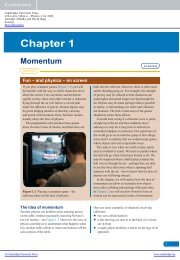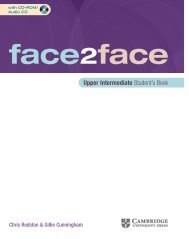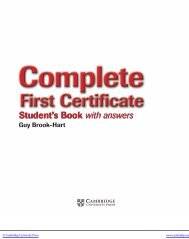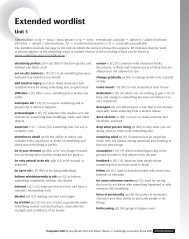Skills for Study Level 2 Teacher's Book - Cambridge University Press
Skills for Study Level 2 Teacher's Book - Cambridge University Press
Skills for Study Level 2 Teacher's Book - Cambridge University Press
Create successful ePaper yourself
Turn your PDF publications into a flip-book with our unique Google optimized e-Paper software.
A final evaluation or suggestionabout what to do, based on thein<strong>for</strong>mation given in the reportStatement of a problem whichneeds to be solved, or a need whichmust be satisfiedRecommendationIntroduction / Background8 Feasibility/recommendation reports – Introduction, backgroundand presentation of options8aAnswers1 IntroductionThis is a recommendation report <strong>for</strong> the supply of drinking water in theheadquarters of KVI Ltd 3 . According to the 1999 Guidelines <strong>for</strong> Health andSafety in the workplace, employers must provide a clean, reliable supplyof drinking water 2 . Though the KVI headquarters building has tap water,complaints about the water quality are frequent. The headquarters buildingis currently unserved by a dedicated drinking water supply system, and staffrely either on municipal tap water or bring their own refreshments to work 1 .Staff representatives and the Human Resources department have discussedwhether this is a suitable level of provision, and it has been decided that KVIheadquarters should investigate alternative options <strong>for</strong> the drinking watersupply. The current tap water supply is compared with a retail vending machineand a serviced water cooler 3 .The three options were compared according to the following criteria:CostAcceptability to staffPerceived taste of the waterEase of supply 42 IntroductionLack of clean household drinking water is a problem facing millions aroundthe world. Traditional means of collecting drinking water have significantdrawbacks, resulting in a need <strong>for</strong> reliable, safe alternative means of obtainingclean drinking water in areas unserved by piped water supplies. Rainwaterharvesting from rooftops has been proposed as a solution to this problem,but is limited by the fact that rainwater is often contaminated by chemicalpollutants. This report compares two methods by which rainwater harvestedfrom a rooftop may be effectively sterilized to make it safe to drink 2 .BackgroundOver 800 million people around the world live without access to a supply ofclean drinking water in the home (WHO/UNICEF, 2010). Water piped directlyinto the home is an unobtainable luxury <strong>for</strong> many in poor rural regions ofdeveloping countries, who must instead make lengthy trips each day to drawwater from remote wells, pumps or standpipes, or must even get their waterfrom unimproved (and untreated) sources such as lakes or rivers. These watersources are not recommended <strong>for</strong> a variety of reasons: the water may beuntreated and contain pollutants; even if the water is treated, if it is drawn froma source which is not maintained properly, it can easily be contaminated bypollutants entering from the air or ground. This can lead to a number of lifethreateningor debilitating diseases (UNICEF, 2009). A further problem with suchUnit 2 Part E ∙ Reporting in writing 71



